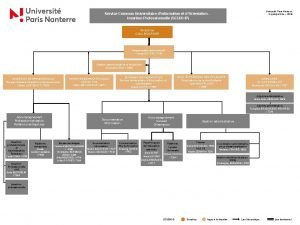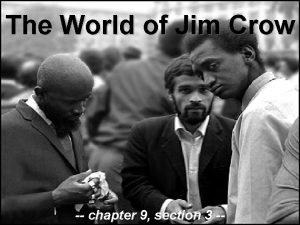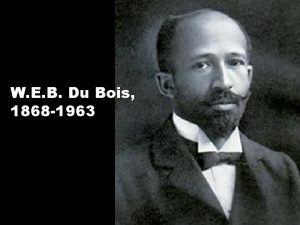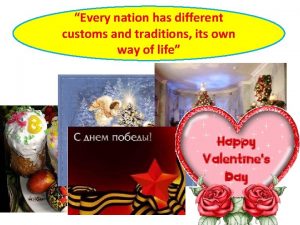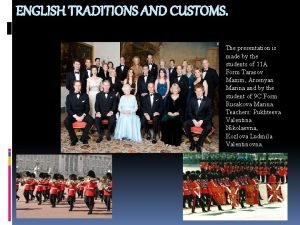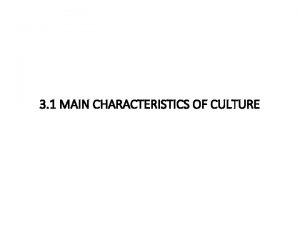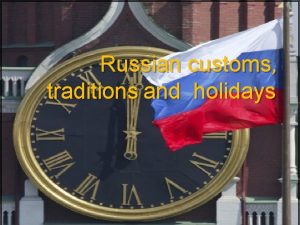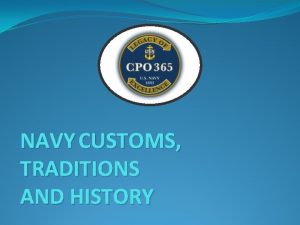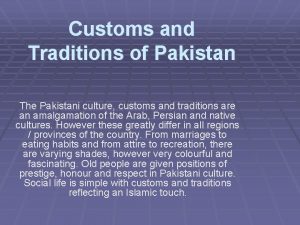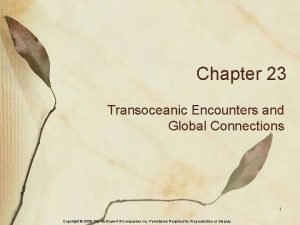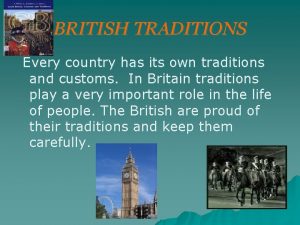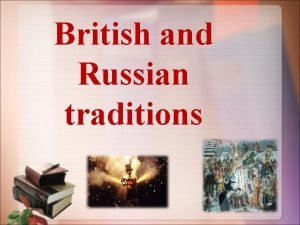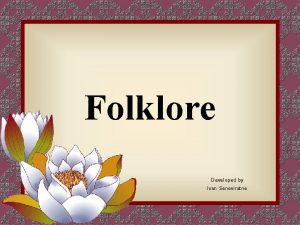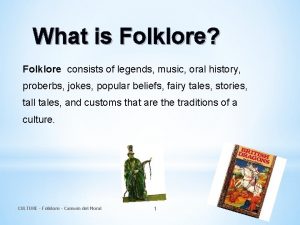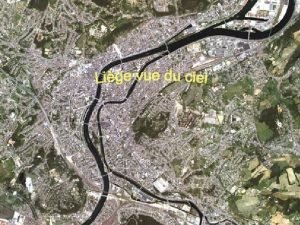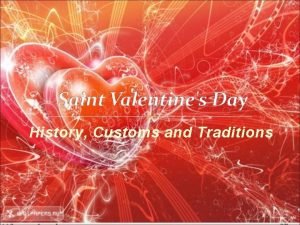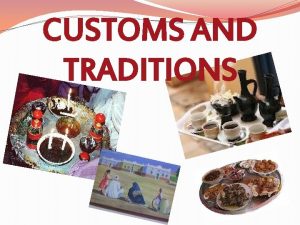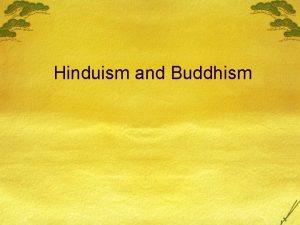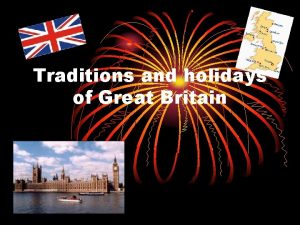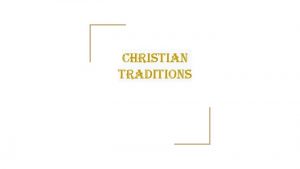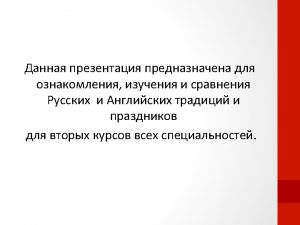Folklore and Traditions in Wallonia UNIVERSIT DE LIGE
























- Slides: 24

Folklore and Traditions in Wallonia! UNIVERSITÉ DE LIÈGE ISLV – INSTITUT SUPÉRIEUR DES LANGUES VIVANTES OCTOBER 2011

General Information 2 • Official name: the Kingdom of Belgium • Population: approximately 11, 007, 020 people • Size: 30, 528 square km • Capital: Brussels • Government: federal parliamentary democracy under a constitutional monarchy • Official languages: Dutch, French and German Belgium is not a homogenous country with one national identity, which also makes our country so rewarding. As such, it is difficult to give a general overview that applies to all Belgians. The three predominant cultures are: 1) In the north = Flanders 2) In the south = Wallonia 3) In the northeast = the German part

1. Carnivals in Belgium 3 A lot of carnivals are very famous in Belgium, above all in the German part of the country. Look at the following pictures! Which one shows the carnival of Binche? 2. Carnival of Binche – the Gille 1. Carnival of Stavelot - the Blancs-Moussis 3. Carnival of Malmédy – the Haguète

Carnival of Binche Where? : in Binche When? : during the three days preceding Lent ( = the 40 weekdays from Ash Wednesday until Easter observed by Christians as a season of fasting in preparation for Easter. ) What? : § stands out as one of the oldest carnivals in Europe, and is now on the UNESCO Heritage list § The ‘Gille’ is the traditional and central character of the carnival. 4

The Gille • He celebrates the return of spring. • They are all men and boys from Binche. • His characteristic features are: - a brightly coloured costume (the national colours of black, yellow and red dominate) - a belt of 7 to 9 bells worn around the waist, as well as a smaller bell on his shirt front - a wax mask which symbolizes equality and a drummer - an impressive ostrich-feather hat - a particular dance • During the parade they give out (or sometimes throw) oranges to the crowd. 5

6

2. The Ducasse of Mons or Doudou 7 Where? : in Mons When? : every year on Trinity Sunday (57 days after Easter) What? : § is a seven hundred-year-old procession and is now on the UNESCO Heritage list §The feast comprises two important parts: -The procession, the descent and the uprising of the Shrine of St. Waudru - The combat of Saint George named “Lumeçon”

8

3. The wallonia festivities: Namur 9 Where? : everywhere in Wallonia (but above all in Namur) When? : on the 3 rd weekend of September What? : § a mass with a sermon in Walloon § popular games § concerts § tasting of Walloon products and alcohol (pèkèt) § combats of jousters on stilts § etc.

Who are they? • The term “Echasseur” describes jousters on stilts. • one of the oldest customs of Namur’s folklore (1411) • Origins: in the Middle-Age whenever the Meuse or the Sambre rivers were flooding → this way of moving became quickly a game! • two groups: the “Melans” (living in the old town) and the “Avresses” (born in the new town) • two colours for the stilts: yellow and black (the Melans) - red and white (the Avresses) • the game: the jousters try to bring down their opponents (using shoulders, elbows, shoving or blocking the stilts, etc. ) 10

11

4. The 15 th August in Liège 12 Where? : in Liège (Lidje in Walloon), in the Outremeuse district When? : the weekend of the 15 th August (for four days) What? : § puppet shows and folk dances § a procession of the Black Virgin § an open-air mass with a sermon in Walloon § a cortege with the parade of the giants § popular games § concerts § etc.

→ Both a religious and a profane tradition! Why? It celebrates the Virgin Mary with a mass in Walloon and a procession of the Black Virgin (with the “Royal Bouquet”). The potales (small niche or chapel - often inset into a wall - to the Virgin) are lit up. This tradition is linked to the important folkloric character and puppet Tchantchès (Walloon for François/Francis). 13

Who are Tchantchès and Nanesse? • According to the legend Tchantchès was born in 760 during Charlemagne's times between two cobble stones in the popular district of Outremeuse (i. e. “beyond the Meuse River”). • The good people who found him were amazed to hear him sing out as soon as he entered the world and ask for a glass of pèkèt. • Tchantchès is the personification of the true, stubborn, hard drinking and sulking person from Liège. • Nanesse his female companion, is courageous and affectionate. 14

15

The end of the festivities on August 16 th is highlighted by the “Burial of the Matî l'Ohê” (Walloon for “Mathieu l’os” / “Mathew The Bone”) → the end, the remains of the party! 16

What about the Belgian food… 17 Our french fries, mussels, white sausages, meatballs “Liège style” (with apple butter), Herve cheese, waffels, the famous “lacquemants” from the funfair, the “bouquette” (a kind of pancake), the “spéculoos”, the “cuberdon” and many other things are wellknown all over the world.

Of course, we are famous for our chocolate and beer too! We have lots of famous chocolate makers: Neuhaus, Leonidas, Galler, etc. We have over 700 different kinds of beer: Trappist beers, Abbey beers, etc. 18

Some famous Belgians… 19 Adolphe Sax (Dinant) (November 6, 1814 – February 4, 1894) was a Belgian musical instrument designer and musician (clarinetist), best known for inventing the saxophone.

René Magritte (Lessines) (21 November 1898 – 15 August 1967) was a Belgian surrealist artist. He became well known for a number of witty and thought-provoking images. His intended goal was to challenge observers' perceptions of reality and force viewers to become hypersensitive to their surroundings.

Jacques Brel (Brussels) (8 April 1929 – 9 October 1978) was a Belgian singer-songwriter. He composed and recorded his songs almost exclusively in French. 21

Hergé (Brussels) (22 May 1907 – 3 March 1983) was a Belgian comics writer and artist. His best known and most substantial work is the twenty-three completed comic books in The Adventures of Tintin series. 22

Georges Simenon (Liège) (February 13, 1903 – September 4, 1989) was a Belgian writer. A prolific author who published nearly 200 novels and numerous short works, Simenon is best known for the creation of the fictional detective Maigret.

Thank you very much for your attention! Merci beaucoup! Mèrci bramint dès côps! 24
 Universit
Universit Rotterdam university economics
Rotterdam university economics Universit of london
Universit of london Université nanterre organigramme
Université nanterre organigramme Universit sherbrooke
Universit sherbrooke Lige daniels
Lige daniels Jeux en lige
Jeux en lige Master lige
Master lige Lige daniels
Lige daniels Unit 4 our customs and traditions
Unit 4 our customs and traditions Every nation has _________ customs and traditions
Every nation has _________ customs and traditions English easter traditions
English easter traditions This is britain easter
This is britain easter British traditions and customs presentation
British traditions and customs presentation Chapter 22 transoceanic encounters and global connections
Chapter 22 transoceanic encounters and global connections Chapter 22 transoceanic encounters and global connections
Chapter 22 transoceanic encounters and global connections Customs and traditions examples
Customs and traditions examples What is the point of uchendu’s lecture to okonkwo?
What is the point of uchendu’s lecture to okonkwo? Customs and traditions in russia
Customs and traditions in russia Naval customs and traditions
Naval customs and traditions Pakistan customs and traditions
Pakistan customs and traditions Traditions and encounters chapter 23
Traditions and encounters chapter 23 Every country has its own traditions and customs
Every country has its own traditions and customs British holidays and traditions
British holidays and traditions Bentley and ziegler
Bentley and ziegler



